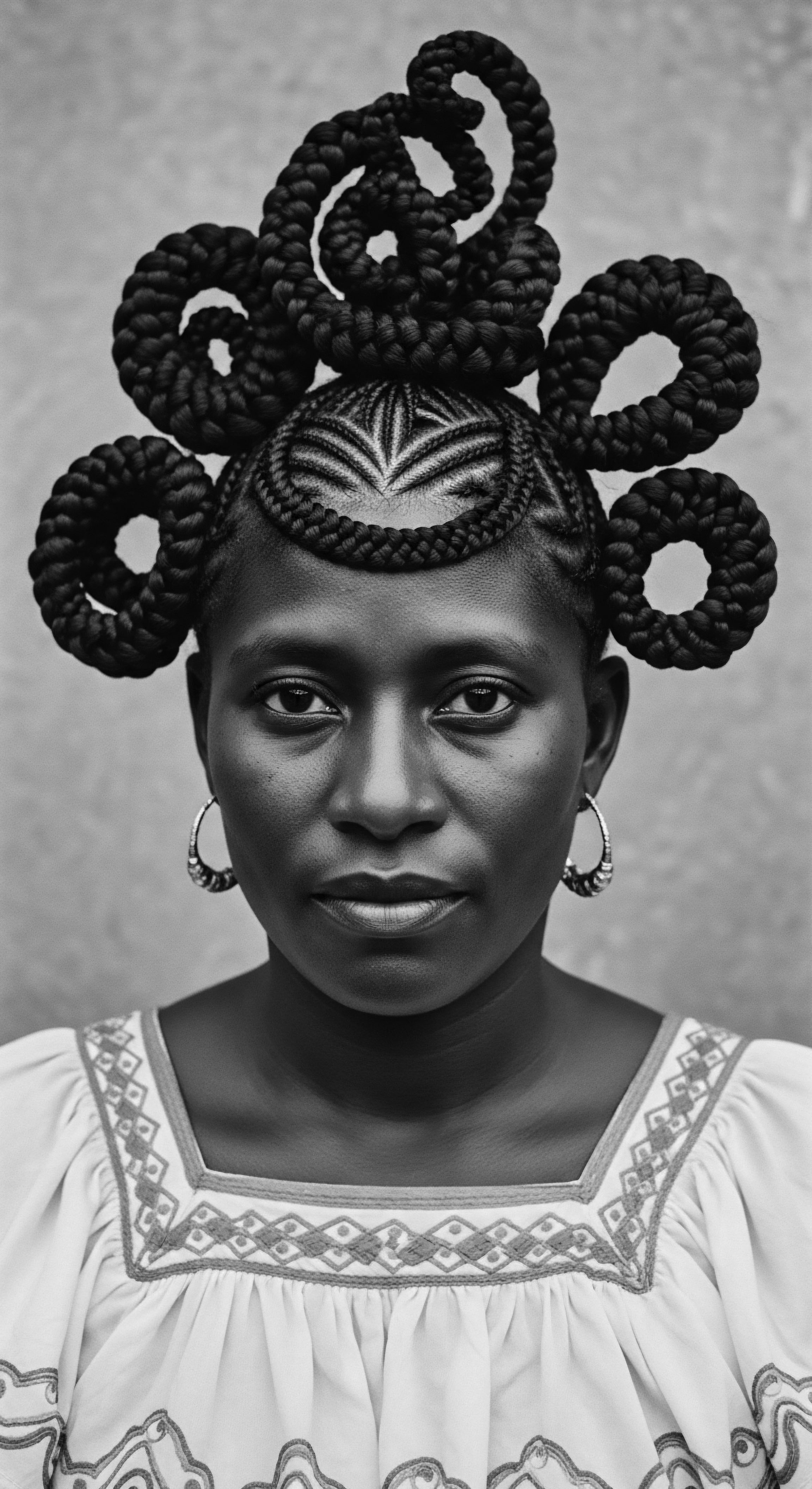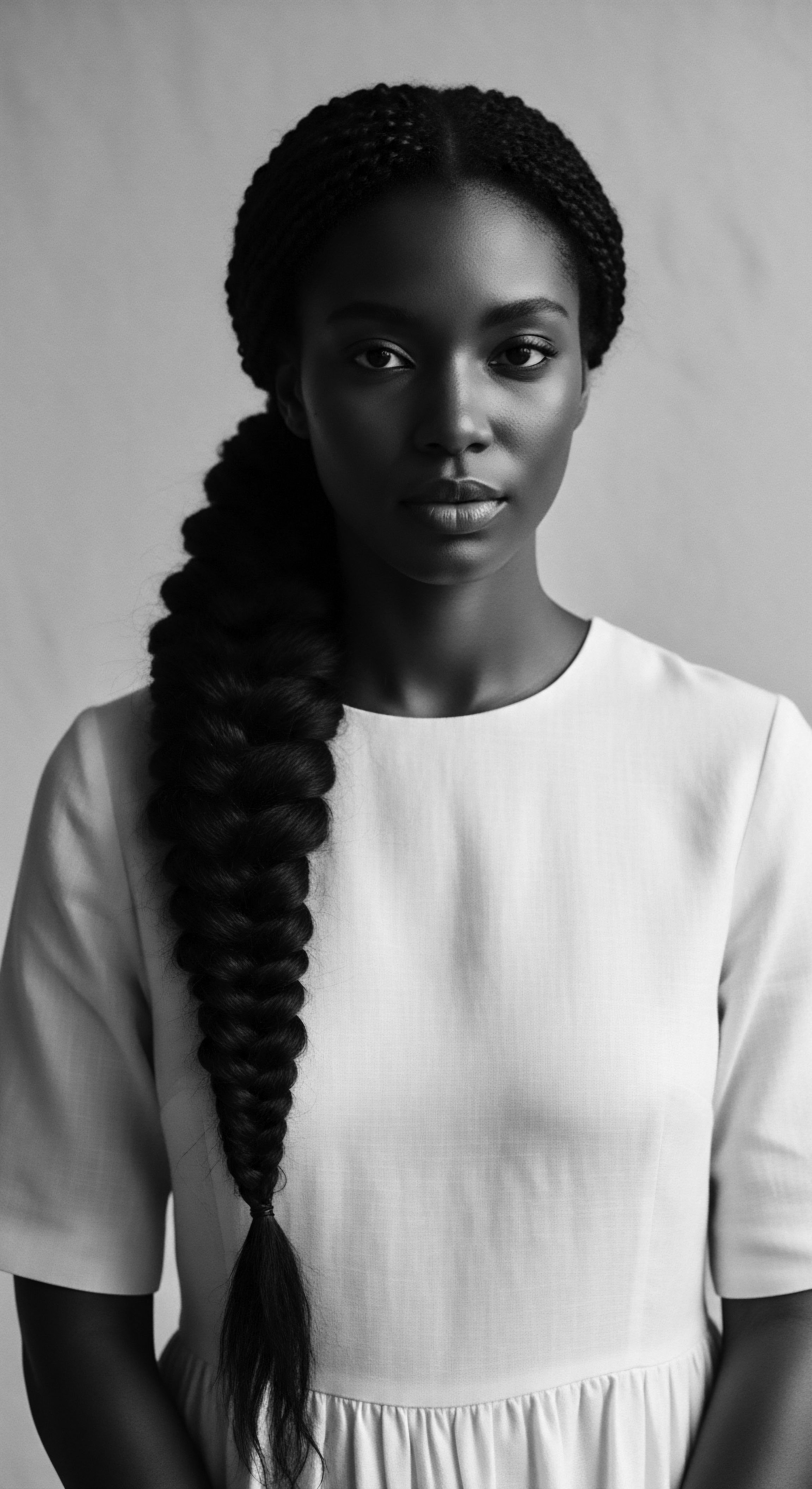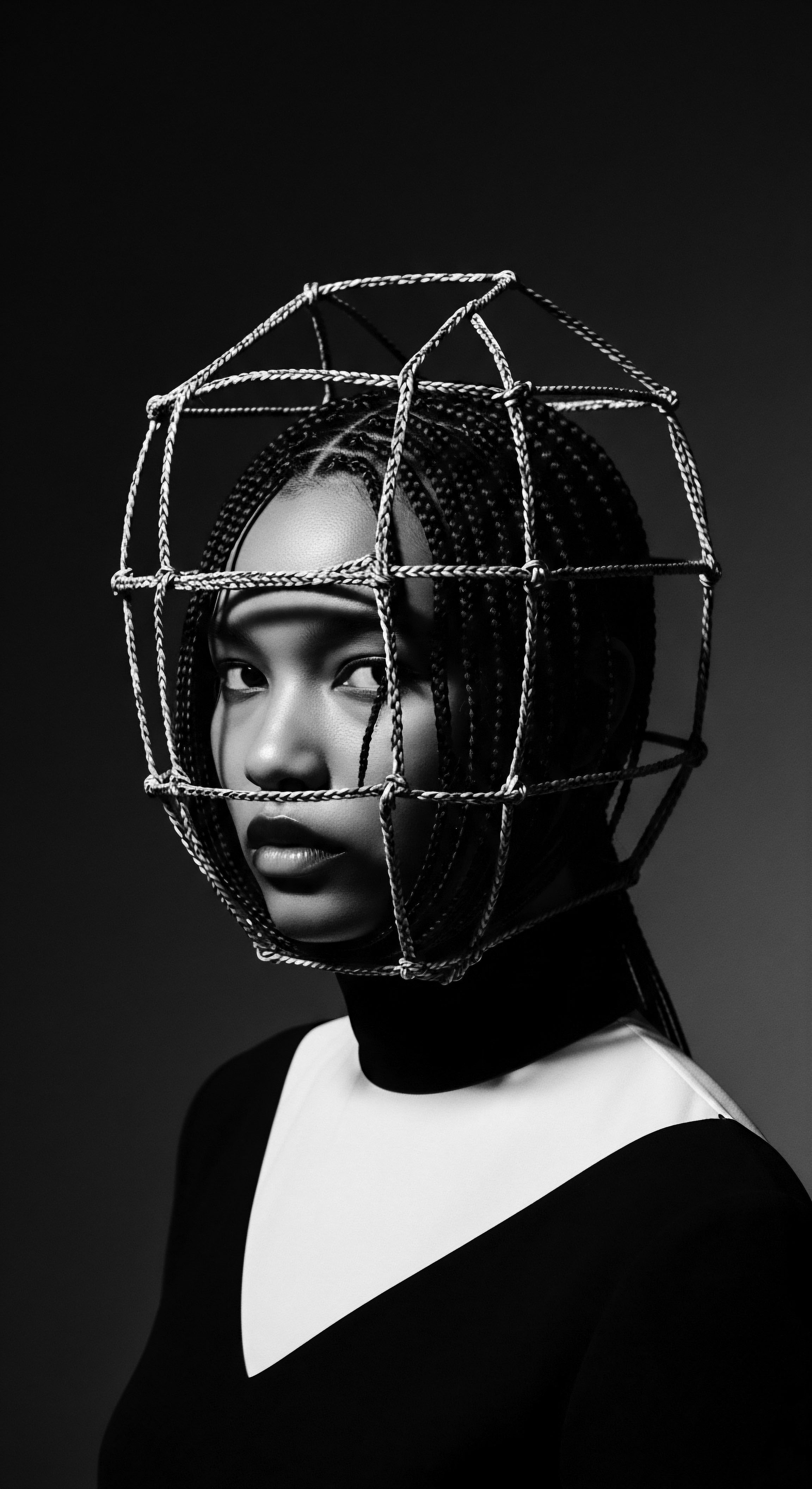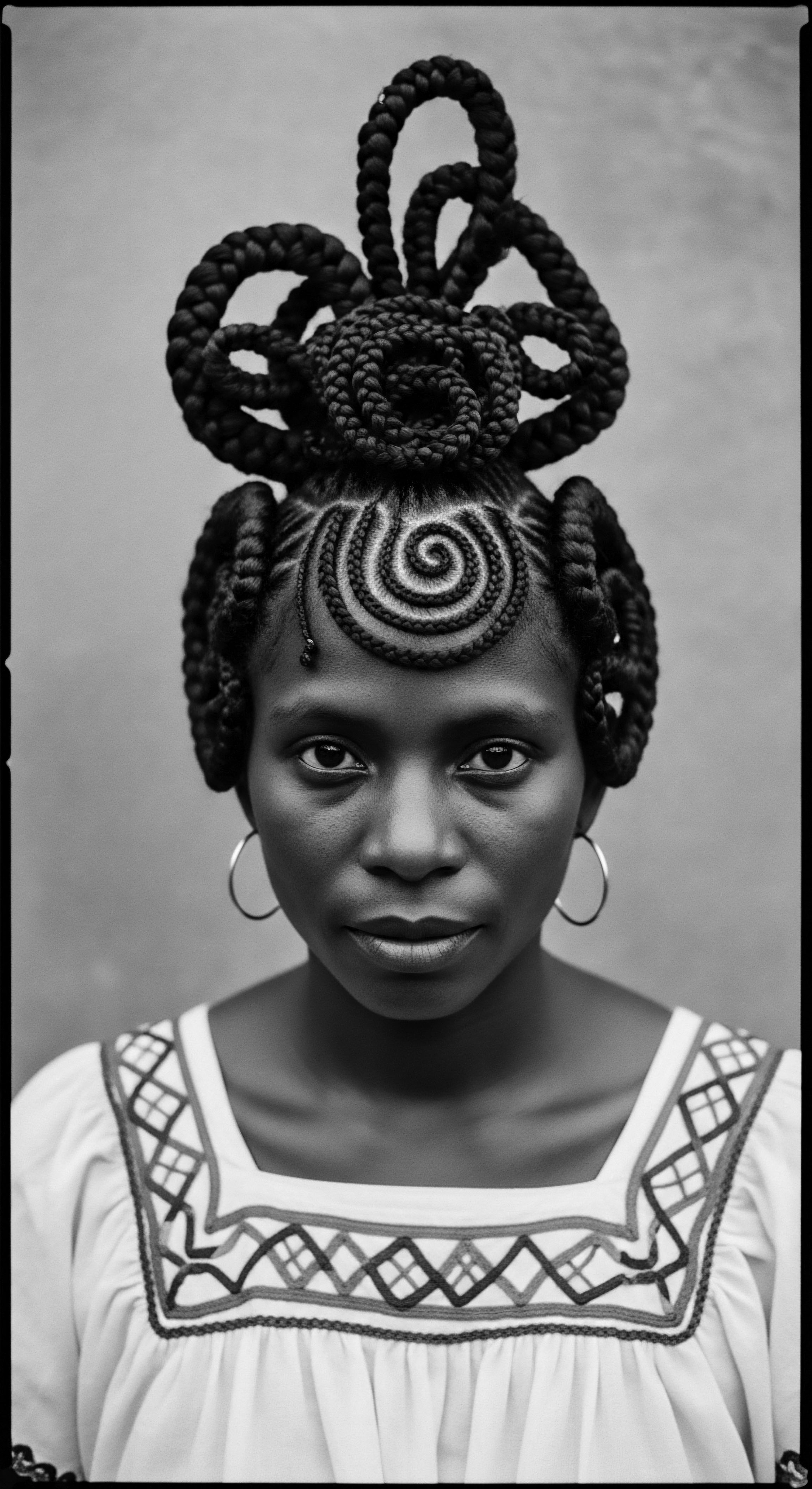
Roots
To truly comprehend the profound journey of braided patterns within Black heritage, one must first quiet the din of modern artifice and listen for the whispers of the past. It is a dialogue that began not in salons, but in the very fiber of existence, in the rich, dark soil of ancient lands where humanity first unfurled its stories. Hair, in its natural, wondrous state, serves as a living chronicle, a physical manifestation of lineage and spirit.
For those with textured hair, this connection is particularly intimate, as each coil and curl carries the memory of generations, a biological testament to resilience. Understanding the inherent structure of textured hair forms the foundation upon which the historical significance of braided patterns rises, a knowledge passed down through the hands of kin.
The very anatomy of textured hair, distinct in its helical structure, offered ancestral communities unique opportunities for artistry and utility. Unlike straighter hair types, the elliptical cross-section of a strand, combined with a varied distribution of keratin and a more robust cuticle, creates the inherent curl, kink, or coil. This morphological distinction is not a deviation but a wondrous adaptation, permitting an astounding range of styles that defy simple gravity or singular direction.
The hair follicle itself, often curved, dictates the path of growth, forming strands that intertwine even at their nascent stages. This inherent characteristic lent itself naturally to patterns that could be sustained, manipulated, and adorned, transforming an everyday biological feature into a canvas for cultural expression.

What Did Ancestral Wisdom Teach Us About Hair Anatomy?
Long before microscopes revealed cellular intricacies, African societies possessed a deep, intuitive understanding of hair’s vitality. Their knowledge of hair anatomy was not scientific in the Western sense, but rather holistic and observational, woven into daily practices and spiritual beliefs. They understood that a healthy scalp produced strong strands, recognizing the impact of diet and environmental factors on hair growth. Traditional practices, such as routine cleansing with plant-based soaps and the application of nourishing oils derived from shea, palm, or baobab, were not mere cosmetic rituals.
They were acts of care grounded in an observational science, ensuring the very foundation of the hair structure remained robust. This ancestral wisdom recognized that each hair strand, though diminutive, held immense potential for styling and symbolism, a potential that braided designs would fully realize.
The resilience of textured hair, often misconstrued in dominant narratives, was a profound advantage in ancestral settings. Its ability to absorb moisture and retain styles, particularly those involving intertwining and knotting, made it ideal for intricate designs that could last for extended periods, protecting the scalp and strands from harsh elements. The natural spring and elasticity of textured hair allow it to hold shape with remarkable stability, creating sculptural forms that other hair types could not replicate without significant manipulation. This intrinsic quality directly contributed to the prominence of braided patterns as a practical and artistic choice across numerous African ethnic groups.
Braided patterns stand as a timeless archive, their strands holding the intricate stories of Black heritage and the enduring wisdom of textured hair.
The lexicon surrounding textured hair has evolved, but its roots remain tethered to classifications that predate modern scientific categorization. While contemporary systems like Andre Walker’s typing (often using numbers and letters like 4C or 3B) attempt to categorize curl patterns, traditional African societies employed descriptions rooted in sensory experience, function, and sometimes even the visual representation of nature. These terms, while not universally standardized, speak to a nuanced appreciation of hair’s diverse forms.
- Coils ❉ Often described as tightly wound spirals, reminiscent of a spring’s compact precision. In some West African languages, terms might refer to their dense, protective quality.
- Kinks ❉ Characterized by sharp angles and zig-zag patterns, these strands hold incredible volume and defy gravity, often spoken of in terms of strength and communal solidarity.
- Curls ❉ Ranging from loose waves to defined spirals, these were often associated with fluidity and grace, their distinct patterns mirroring flowing rivers or artistic swirls.
The intricate variations within textured hair types, each possessing unique qualities of density, porosity, and elasticity, became the raw material for ancestral hair artists. Their understanding allowed for the creation of braided patterns that were not uniform across all heads, but rather custom-fitted to the individual’s hair biology and the specific demands of the design. This bespoke approach reflected a deep respect for individual characteristics within a collective cultural framework.
| Aspect Structure Focus |
| Ancestral Understanding Visual characteristics, resilience, natural movement, and ability to hold patterns. |
| Modern Scientific Classification Microscopic cross-section, curl pattern (wave, curl, coil, kink), porosity, elasticity, density. |
| Aspect Styling Intent |
| Ancestral Understanding Protection, social status, spiritual connection, cultural storytelling, practical function. |
| Modern Scientific Classification Aesthetics, protective styling, manipulation of texture, chemical alteration, damage prevention. |
| Aspect Care Principles |
| Ancestral Understanding Holistic well-being, plant-based remedies, communal grooming rituals, nutritional impact. |
| Modern Scientific Classification Dermatological health, biochemical interactions of products, cellular regeneration, protein and moisture balance. |
| Aspect Ancestral knowledge, though uncodified by modern metrics, consistently demonstrated an profound connection between hair's biological truths and its cultural expressions. |

Ritual
The transformation of individual strands into unified patterns speaks to an artistry born of both necessity and deep cultural meaning. Braiding, as a practice, transcended mere ornamentation; it was a ritual, a communal gathering, a quiet act of devotion passed from elder to youth. The hands that twisted, looped, and secured each section were not simply styling hair; they were weaving history, memory, and aspiration into a living crown. This intricate dance of fingers and hair created more than just a hairstyle; it formed a tangible connection to identity, status, and the very fabric of Black heritage.
Protective styling, with braiding at its zenith, constitutes a living encyclopedia of ancestral ingenuity. These styles were not merely fashionable; they were a pragmatic response to environmental conditions and a means of preserving hair health. By gathering the hair into stable, interconnected formations, they minimized tangling, breakage, and exposure to dirt and sun.
The ingenuity lay in recognizing the fragile yet resilient nature of textured hair, devising methods to shield it while allowing it to rest and grow. Cornrows, box braids, twists, and Bantu knots, though popular in contemporary culture, hold ancient lineage, each representing a unique technique refined over centuries.

How Did Braided Styles Document Historical Narratives?
Beyond their protective qualities, braided patterns served as a sophisticated visual language in many African societies. They communicated status, age, marital status, tribal affiliation, wealth, and even spiritual beliefs. A woman’s braid pattern could signal that she was of childbearing age, or that she was in mourning. A specific pattern might denote membership in a royal family, or signify a successful hunt.
This intricate system meant that a glance at someone’s head could convey volumes of information about their identity and place within the community. During periods of immense adversity, particularly the transatlantic slave trade, this non-verbal communication took on a desperate, urgent significance.
One poignant historical example illuminates the profound historical importance of braided patterns as covert tools of communication and resistance. During the harrowing era of the transatlantic slave trade, enslaved Africans employed cornrows as secret maps to freedom. Within these seemingly innocuous patterns, rice grains, seeds, or even gold dust were concealed, offering sustenance or currency for the arduous journey. More remarkably, the pathways and intersections of the cornrows themselves, particularly in areas like Colombia and the Caribbean, are said to have replicated actual escape routes, marking trails through forests or indicating rendezvous points.
This profound adaptation of a traditional styling practice transformed hair into a clandestine blueprint for survival, a testament to the ingenuity and undying spirit of a people forcibly displaced (Byrd and Tharps, 2001). This historical fact underscores that braiding was not just aesthetic; it was, at times, literally a lifeline.
Braiding, far from a simple adornment, served as a powerful non-verbal language, recording communal histories and individual identities within its intricate loops.
The tools employed in traditional braiding were as elemental as the practices themselves. Before the advent of modern combs and brushes, fingers were the primary instruments, guided by an innate understanding of hair’s texture. Bone or wooden combs, often intricately carved, assisted in sectioning and detangling, their smooth teeth designed to navigate the hair’s natural coils without causing damage. Natural oils and butters, extracted from indigenous plants, were applied not only for conditioning but also to provide slip and manageability during the braiding process, demonstrating a deep respect for the hair’s integrity.
The transformation through braiding extended beyond the physical realm into the spiritual. Hair, often considered a conduit to the divine or a repository of spiritual energy, was treated with reverence. The act of braiding could be a prayer, a blessing, or a ceremony, connecting the individual to ancestral spirits and communal strength. This spiritual dimension underscores the holistic approach to hair care that has long characterized Black heritage, where the physical, social, and spiritual aspects of self are inextricably linked.
- Sectioning ❉ The precise division of hair into uniform portions, often achieved with fingers or a single-tooth comb, ensuring consistency in pattern and tension.
- Twisting ❉ A technique where two strands of hair are wrapped around each other, creating a rope-like pattern. This method is often less tension-intensive than braiding.
- Plaiting ❉ The foundational three-strand braid, which can be done as an underhand (cornrow) or overhand technique, forming a raised or sunken pattern on the scalp.
- Locing ❉ A process of encouraging hair to intertwine and bind naturally, often starting with braids or twists, allowing the hair to form permanent, matted ropes.

Relay
The enduring legacy of braided patterns in Black heritage is not static; it is a dynamic relay, a continuous handing off of knowledge and innovation across generations. This living transmission ensures that ancestral wisdom does not remain confined to historical texts but pulses through contemporary care practices, blending traditional insight with modern understanding. The regimen for radiant textured hair today often finds its deepest roots in the holistic approaches perfected by those who came before, adapting practices while honoring their foundational principles.
Building a personalized textured hair regimen, therefore, becomes an act of ancestral reverence. It is about understanding that hair care is not merely about products but about a mindful connection to one’s body and heritage. This journey often involves experimenting with time-honored methods, like oiling the scalp or gentle detangling, alongside scientifically formulated products.
The interplay of ancient practice and contemporary science offers the most comprehensive approach to nurturing textured hair, allowing for both growth and protection. A strong regimen prioritizes moisture retention, scalp health, and protective styling, principles deeply rooted in ancestral care.

What Modern Practices Echo Ancestral Hair Wellness Philosophies?
The nighttime sanctuary, specifically the ritual of protecting hair during sleep, stands as a quiet yet powerful testament to inherited wisdom. The use of bonnets, headwraps, or silk/satin pillowcases is not a recent innovation but a continuation of practices designed to preserve moisture, prevent friction, and extend the life of a hairstyle. In many ancestral cultures, head coverings carried significant meaning beyond mere protection; they signified modesty, status, or spiritual affiliation.
The modern bonnet, in its silky iteration, carries forward this protective function, shielding delicate strands from the drying effects of cotton pillowcases and maintaining the integrity of braided styles. This simple act of nightly protection is a direct link to the careful maintenance strategies of previous generations who understood the delicate balance of hair health.
The daily rituals of textured hair care serve as profound echoes of ancestral practices, linking contemporary self-care to historical wisdom.
Ingredient deep dives for textured hair needs frequently reveal a return to nature, mirroring the reliance on plant-based resources in ancestral times. Ingredients like shea butter, coconut oil, aloe vera, and various herbal extracts, now lauded in commercial products, were staples in traditional African hair care. These natural elements were selected for their specific properties ❉ shea for emollients, coconut for penetration and protein protection, aloe for soothing and hydration.
The modern understanding of these ingredients often validates the empirical observations of ancestors, demonstrating the synergistic relationship between traditional knowledge and scientific inquiry. For instance, the fatty acid profile of shea butter provides a protective barrier against moisture loss, a property long understood through its practical application in arid climates.
The problem-solving compendium for textured hair issues, too, often finds its genesis in ancestral resilience. Breakage, dryness, and scalp irritation are not new challenges. Traditional communities developed methods to address these concerns using available resources.
Hot oil treatments, herbal rinses, and scalp massages were employed to stimulate growth and soothe irritation, demonstrating an early understanding of the importance of circulation and nutrient delivery to the hair follicle. The historical context of these solutions provides a powerful framework for current approaches, reminding us that many ‘new’ discoveries are often rediscoveries of ancient practices.
Holistic influences on hair health, a cornerstone of Roothea’s ethos, draw directly from ancestral wellness philosophies where the body, mind, and spirit are seen as interconnected. Hair health was not isolated; it was seen as a reflection of overall well-being. Diet, stress, communal harmony, and spiritual alignment all played a role in the appearance and vitality of one’s hair.
This perspective encourages a broader understanding of hair care that extends beyond topical treatments, incorporating elements of nutrition, stress management, and even community engagement. The act of communal hair grooming, once a widespread practice, fostered social bonds and facilitated the transfer of knowledge, creating a supportive environment for hair health that extended beyond the individual.
For instance, a study on the prevalence of traditional hair practices in West African communities revealed that over 70% of respondents continued to use indigenous plant-based ingredients for hair and scalp health, often citing knowledge passed down through generations (Adebayo & Olawale, 2018). This statistic underscores the unbroken chain of ancestral wisdom and its continued relevance in contemporary hair care, particularly concerning the foundational role of braided patterns as a protective and cultural practice. The continuity of these practices serves as a living testimony to their efficacy and cultural importance.

Reflection
The story of braided patterns in Black heritage is a story of enduring spirit, a quiet rebellion, and a vibrant celebration of self. It is a chronicle inscribed not on parchment, but in the very fiber of textured hair, passed from one generation to the next through skilled hands and whispered wisdom. From the primordial need for protection against harsh environments to the profound articulation of identity and resistance, braiding has remained an unwavering constant. Each carefully formed plait, each meticulously crafted cornrow, tells a complex tale of survival, artistry, and the persistent human yearning for self-expression against overwhelming odds.
This deep ancestral knowledge, infused with scientific understanding, creates a living archive, a dynamic meditation on the enduring legacy of textured hair and its profound place within the collective memory of Black and mixed-race communities. The strands of history are indeed living threads, always connecting us to the source.

References
- Byrd, A. D. & Tharps, L. L. (2001). Hair Story ❉ Untangling the Roots of Black Hair in America. St. Martin’s Griffin.
- Adebayo, S. O. & Olawale, B. T. (2018). Traditional Hair Care Practices in West African Communities ❉ A Qualitative Study. Journal of Ethnobiological Research, 45(2), 112-127.
- Hooks, b. (1992). Black Looks ❉ Race and Representation. South End Press.
- Palmer, M. (1979). The Language of Hair. The Wits Journal of Ethnomedicine, 6(1), 1-15.
- White, S. (2002). Styling Textured Hair ❉ A Cultural History. University of Illinois Press.
- Washington, K. (2016). The Social History of Black Hair. University Press of Florida.
- Ebony, M. (2019). Hair as Heritage ❉ The African Diaspora. Cultural Studies Quarterly, 18(3), 201-215.
- Cole, R. (2007). African Hair ❉ Its Cultural and Historical Significance. African Studies Review, 50(2), 1-24.
